Off-grid solar power battery maintenance
An off-grid solar power system is not plug-and-play and the biggest part of the work is maintaining the battery bank. This page talks all about that.
Table of Contents
Checking Depth of Discharge (DOD)/State of Charge (SOC)
Equalizing your batteries
Topping up batteries with distilled water
Cleaning the batteries
Checking Depth of Discharge (DOD)/State of Charge (SOC)
A battery is fully discharged when it can no longer give a useful current (flow of electrons) for your application. As you use it, the voltage drops too. The depth of discharge (DOD) is how much has been discharged. For example, a 20% DOD means 20% of its capacity has been discharged. The State of Charge (SOC) is just the opposite of the DOD. If the DOD is 20% then the SOC is 80%: 20% discharged is the same as saying 80% remaining charge - the glass is either 20% empty or 80% full.
The general rule-of-thumb is do not discharge more than 50%. Basically, the deeper you discharge it on a regular basis the shorter the useful lifetime of the battery. A battery has reached the end of it's lifetime when you the battery can't hold as much of a charge anymore; it'll do less and less between recharges.
The most accurate thing to use to find out the DOD of a battery is to measure the specific gravity of the fluid inside it, done using a hydrometer. You can also tell the DOD by using an amp hour meter (battery status meter) or the battery's voltage but these are less accurate and can be wrong depending on when you measure it (more on this in the Use a amp hour meter and Use the voltage subsections below.)
Here's a chart relating voltage and specific gravity to DOD and SOC.
| DOD | SOC | 2 volt battery | 12 volt battery | 24 volt battery | 48 volt battery | specific gravity |
|---|---|---|---|---|---|---|
| 0% | 100% | 2.10 | 12.70 | 25.40 | 50.80 | 1.265 |
| 10% | 90% | 2.09 | 12.58 | 25.16 | 50.32 | 1.249 |
| 20% | 80% | 2.08 | 12.46 | 24.92 | 49.84 | 1.233 |
| 30% | 70% | 2.06 | 12.36 | 24.72 | 49.44 | 1.218 |
| 40% | 60% | 2.05 | 12.28 | 24.56 | 49.12 | 1.204 |
| 50% | 50% | 2.03 | 12.20 | 24.40 | 48.80 | 1.190 |
| 60% | 40% | 2.02 | 12.12 | 24.24 | 48.48 | 1.176 |
| Discharged | Discharged | 1.75 | 11.90 | 23.80 | 47.60 | 1.120 |
To check how much has been discharged:
- measure the specific gravity using a hydrometer (not for sealed batteries),
- use a amp hour meter, or
- use the voltage.
These three are discussed below.
Measure the specific gravity using a hydrometer
If you have flooded lead acid batteries, ones with caps on top that you can remove to get at the liquid inside, then you can measure the specific gravity using a hydrometer. You'd then look up the specific gravity in the above table to find the DOD. If you have sealed batteries then there are no removable caps and you can't do this.
Use an amp hour meter
An amp hour meter doesn't measure the battery bank's state of charge (SOC) directly. Instead it monitors the current going to and from the battery bank and uses that to deduce the SOC. It does this through the use of a shunt.
Use the voltage
Measuring the voltage of a battery bank to find out the state of charge (SOC) is less reliable than measuring the specific gravity, however, if you do it right it at least gives you a quick indication which you can then use with the SOC table above to find out roughly the battery bank's SOC.
Equalizing your batteries
A solar system battery bank is made up of multiple batteries and each battery is made up of one or more cells. After charging, the specific gravity may vary between all the cells in the battery bank. Equalization is a way to bring each cell up to full charge. It basically involves doing a controlled overcharging of the battery bank. Equalization reduces stratification and sulfation in the cells.
For preventative maintenance, some battery manufacturers such as Surrette (Rolls) recommend that batteries should be equalized once every six months. An alternative approach is to use a hydrometer to measure the specific gravity of all your cells after having done a full charge to see if any are significantly lower than the others and only do an equalization if that's the case. The former approach is for people who don't want to pay attention to their battery banks and instead program their charger (e.g. their charger controller) to periodically do it without them knowing.
The equalization is typically done by your charge controller fed by free solar power but sometimes your inverter, if it contains a charger, fed by a generator. Your charger may allow you to enter a voltage for the equalization and a length of time to do it. The charger will start charging the battery bank until the voltage is reached and hold it there for the allotted time.
The voltage you use should be one suggested by your battery manufacturer. For example, here are ranges of values suggested by Surrette (Rolls):
| Voltage | |
|---|---|
| Volts per 2 volt cell | 2.58-2.67 (max) |
| 12 volt battery bank | 15.5-16.0 |
| 24 volt battery bank | 31.0-32.0 |
| 48 volt battery bank | 61.9-64.1 |
Topping up batteries with distilled water
Flooded lead acid batteries contain a mixture of sulfuric acid and water. Water is itself made up of hydrogen (H) and and oxygen (O), hence its molecular formula H2O. As a battery is undergoing charging or a load is being run off of the batteries, some of the water breaks down into hydrogen and oxygen in gaseous form which can escape from the batteries. This means the water is gradually disappearing from the batteries.
Sealed batteries don't have this problem. For non-sealed batteries hydrocaps are available which replace the existing caps on each cell of your battery. These hydrocaps capture the hydrogen and oxygen gas before they escape and turn them back into water which falls back down into the battery. However, even with hydrocaps, some will escape.
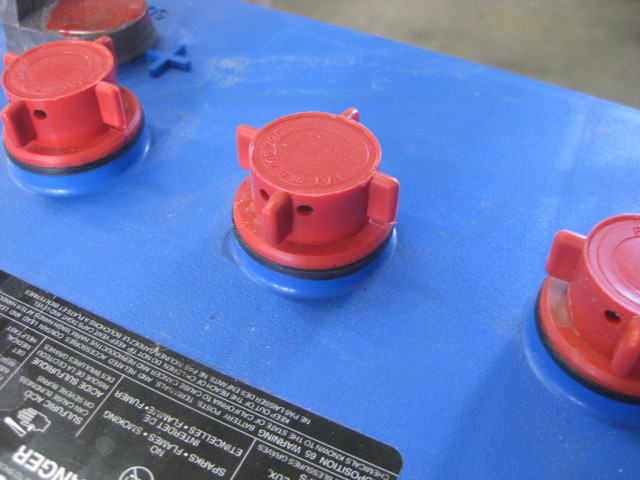
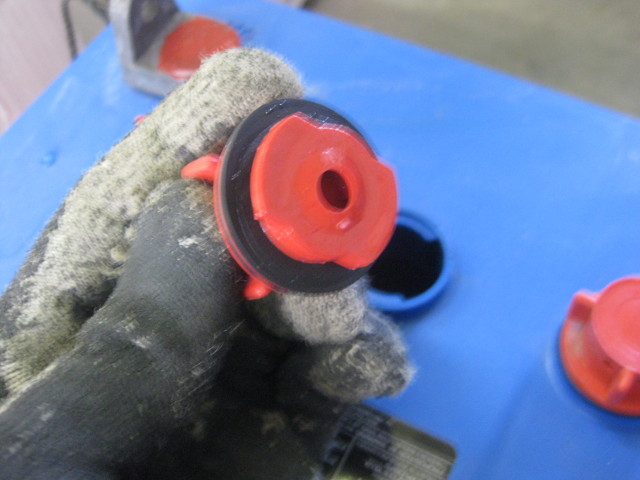
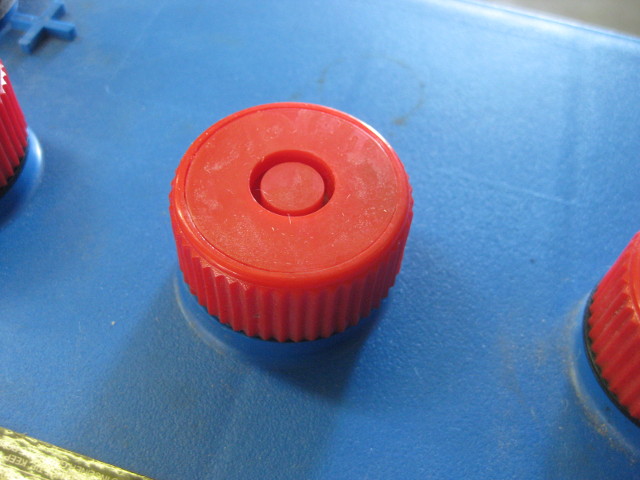
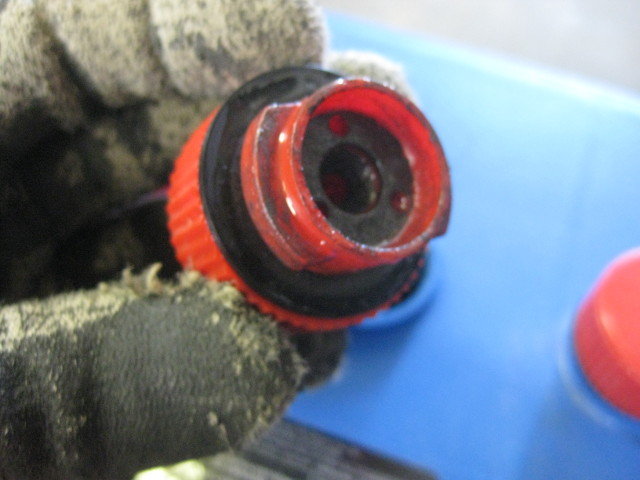
If you don't have sealed batteries then you need to check the level of the fluid in your batteries and top it up as needed. You do not need to add sulfuric acid ever. Each battery is made up of one or more cells. You can tell how many cells there are because there is one cap per cell. To get inside the cell you simply open the cap. Sometimes they twist off and sometimes you pull them off using a tab on one side. The caps in the above photos are twist off types.
Before you remove a cap, make sure the top of the battery is clean. You don't want any dirt to fall into the cell.
You don't want the fluid to get below the level of the lead plates within the batteries. But you also don't want it to be filled to the very top either since when batteries are under heavy charging or load they bubble and may leak out the top if the fluid is already normally at the top. You battery manufacturer will recommend a level to fill them to but in general don't ever let the level get to the top of the lead plates inside.
Top the batteries up with distilled water only. This can be found at grocery stores and drug stores and is normally used for cleaning contact lenses. It often comes in 4 litre/1 gallon containers.
How often you'll have to do this depends on your system usage. Heavy charging and heavy loads both result in more water loss than light charging and light loads. With a new system, check once a week. Over time you'll get an idea of how often you need to do this.
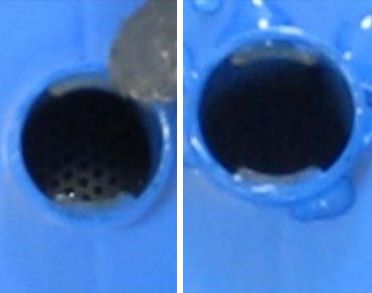
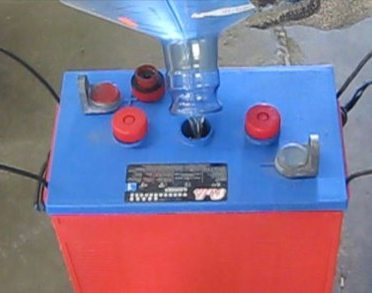
Cleaning the batteries
The hydrogen and oxygen that escape from the battery does so through the cap. Some of this may condense on the top of the battery. This fluid is electrically conductive and slightly acidic. Since it's electrically conductive and on top of the battery, it can create a small conductive path between one battery post and the other. As such it will act like a small load that is always turned on. It looks like a thin, shiny film of water.
Since it is acidic you can clean it using normal household baking soda, available in the baking section of your grocery store. I usually just pour a thin layer of baking soda straight out of the box onto the top of the battery. As the baking soda neutralizes the acid you'll see it fizzle. Rather than use straight baking soda, many people use a solution of 100 grams of baking soda per litre of water or 4 ounces per pint.
It's very important that you don't get any baking soda into the cells of the battery since it neutralizes acid. Also, you should wear gloves when you do this. Ones made of PVC are good (ie. most kitchen gloves.)
After you've put the baking soda on, you can wipe it off with a damp rag. Since I pour on dry baking soda straight from the box I first get as much off as I can using a shopvac and then wipe it with a damp rag. You can rince the rag off in the sink.

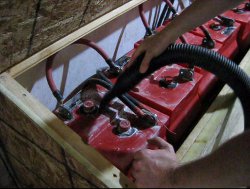
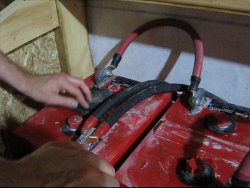
Working safely with batteries
Warning: These batteries contain sulfuric acid as well as water. Always wear goggles and rubber or PVC gloves when working with them.
Warning: As a habit, do not touch two battery terminals at the same time with your hands. It's actually safe to do so but batteries and especially many batteries connected together contain a lethal amount of current that can kill you or at least badly burn you. Do not touch two terminals with any metal object (a wrench, screw driver, wire.) If you do you will hear a loud bang, see a bright spark and the metal object will actually melt where it touched a terminal. As a habit, do not sit tools temporarily on top of the batteries or where they can fall onto the batteries.
Warning: The acid from batteries is weak since it's mixed with water but it will eat most clothing. If you see holes appearing in your clothes the next day then you got acid on them. Polyester will not be affected so I always wear polyester pants when working on batteries. I've ruined a few jeans this way though.



